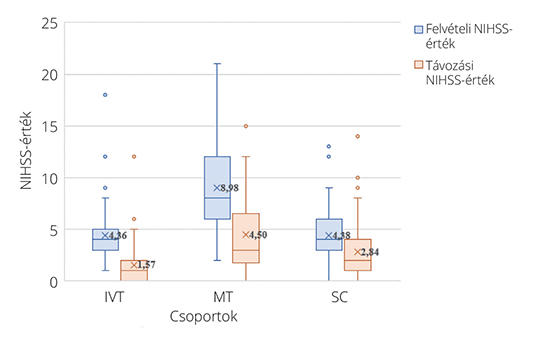[Stroke is a serious health problem that has a significant impact on health-related quality of life. Despite the increasing popularity of measuring quality of life among patients, it is not routinely measured in clinical practice, and therefore little is known about how well clinical measures reflect quality of life after stroke. The aim of this study was to investigate the quality of life of patients with acute ischaemic stroke.
For the prospective study, patients diagnosed with acute ischemic stroke at the Neurology Clinic of the Clinical Center of the University of Pécs were selected through convenience sampling between June 2022 and May 2023. Based on the treatments, patients were divided into three groups: mechanical thrombectomy (MT), intravenous thrombolysis (IVT), and standard care (SC). Modified Rankin Scale (Pre-mRS, Follow-up mRS), NIH Stroke Scale (NIHSS), and European Quality of Life 5 Dimensions Scale (EQ-5D-5L) were used in the research. Descriptive statistics, paired T-tests, Wilcoxon tests, McNemar tests and Pearson correlation analysis were applied for the analysis (SPSS 25.0; p <0.05).
A total of 198 participants (115 males, 83 females) took part in the study (MT: 50, IVT: 69, SC: 79). The Pre-mRS and follow-up mRS values indicate that the majority of patients in all three groups fell into the mild category (Pre-mRS: 176 participants; 88%, follow-up mRS: 158 participants; 80%). There was a significant improvement in NIHSS scores in all three groups (IVT: 4.36 vs. 1.57, p<0.001; MT: 8.98 vs. 4.50, p<0.001; SC: 4.38 vs. 2.84, p<0.001). The EQ-5D-5L value also significantly increased for all groups (IVT: 0.82 vs. 0.88, p<0.001; MT: 0.63 vs. 0.73, p<0.001, SC: 0.76 vs. 0.80, p=0.014). Patients admitted with lower NIHSS values reported better quality of life at the end of our study (r: -0.43451).
At 30 days, significant improvement was observed in MT, IVT and SC groups when measured with EQ-5D-5L, but the extent of improvement was highest in the MT group.]




